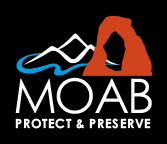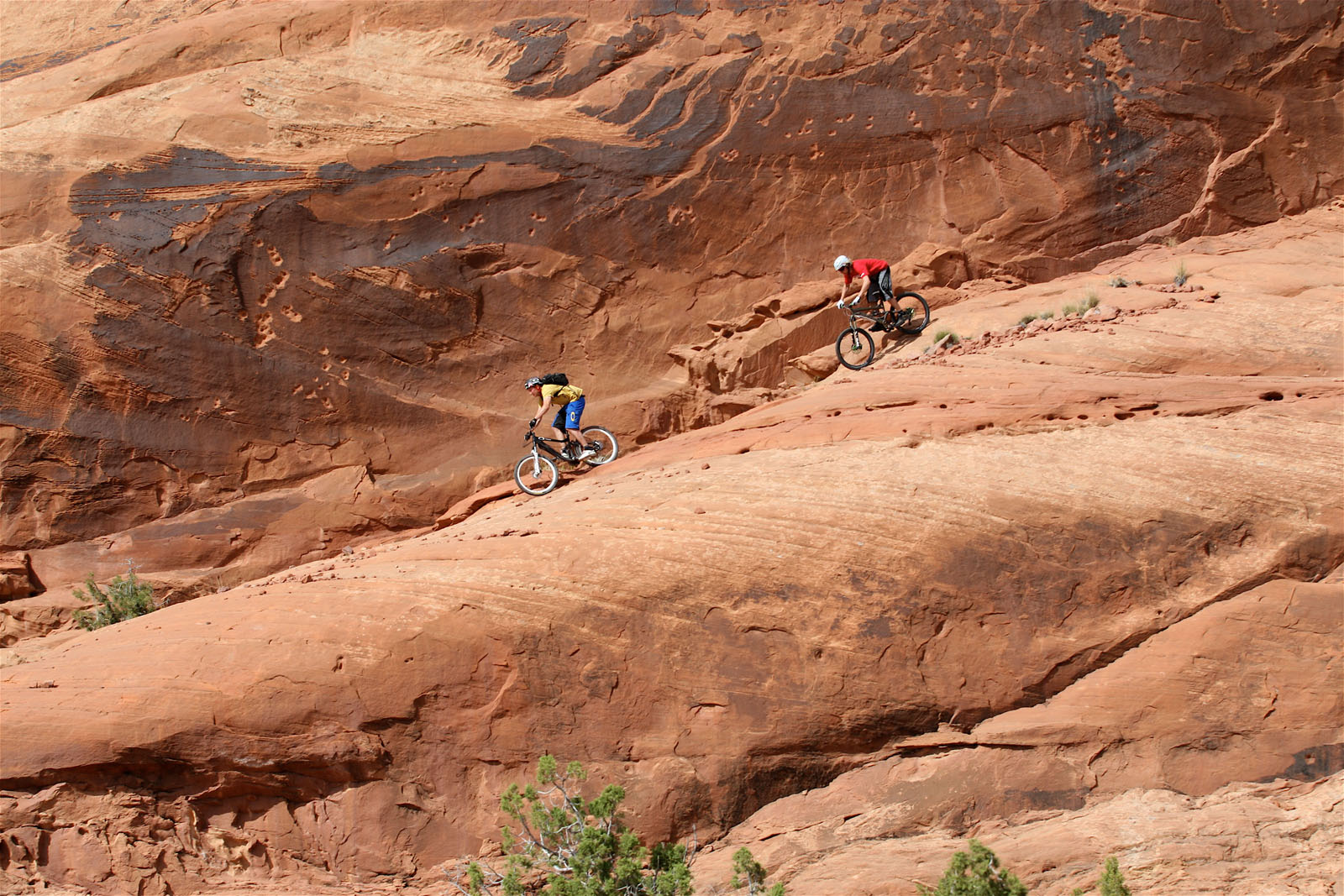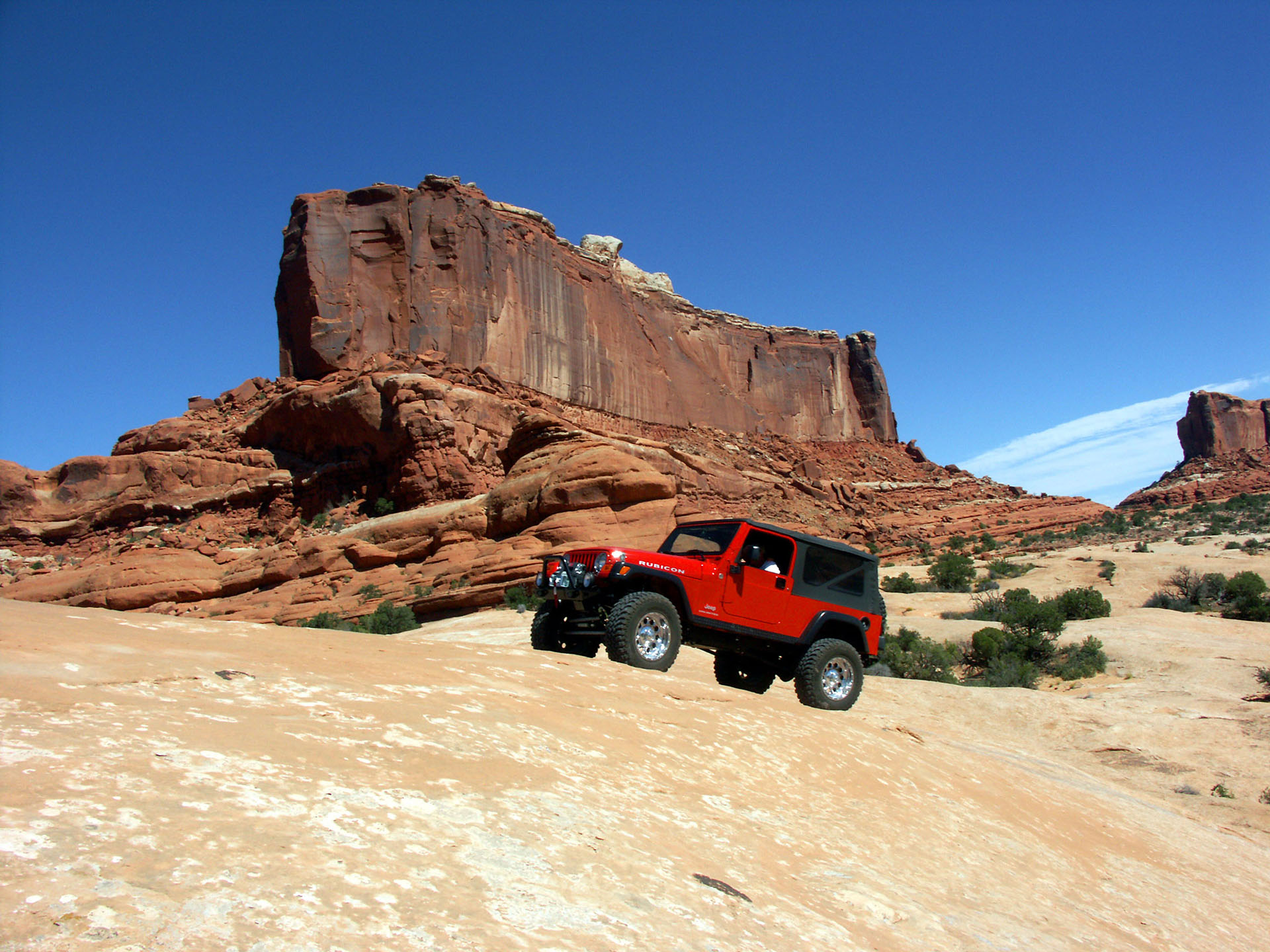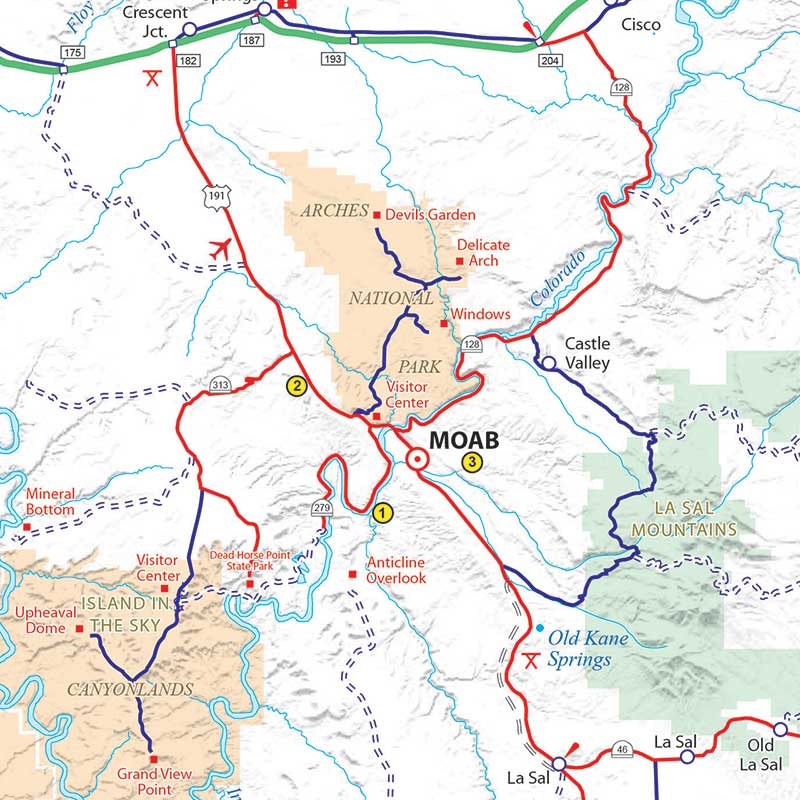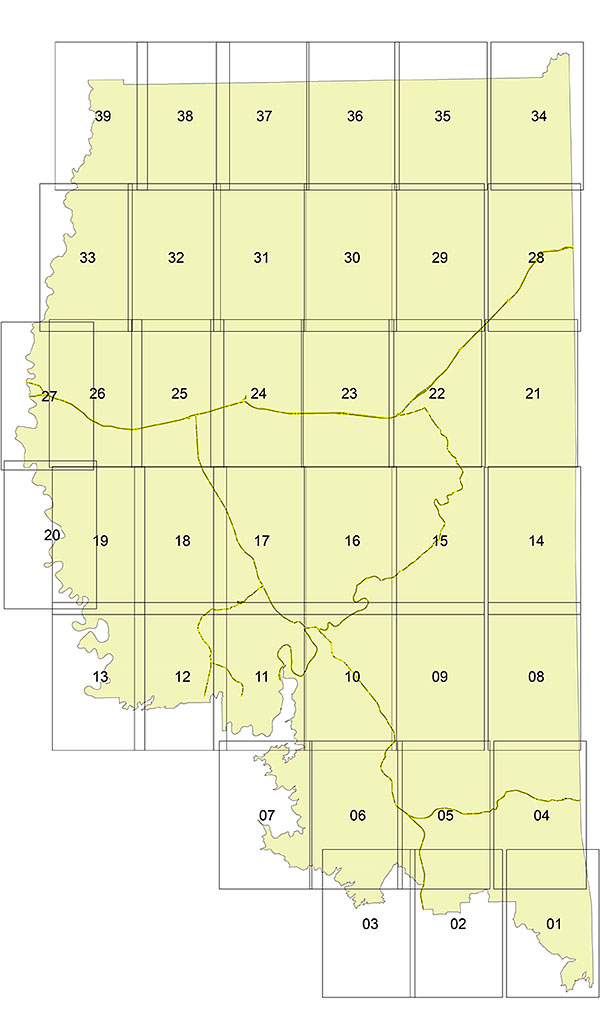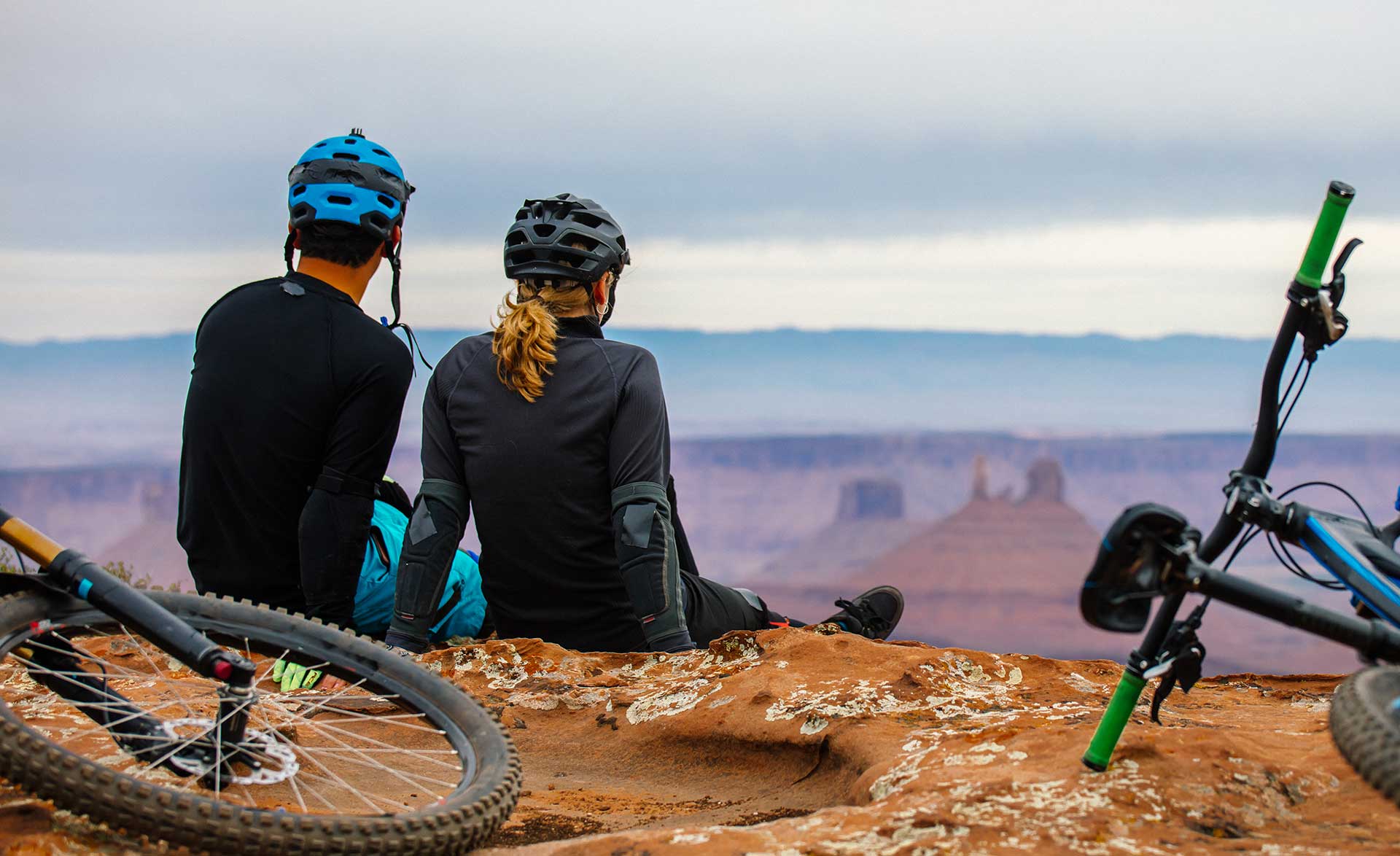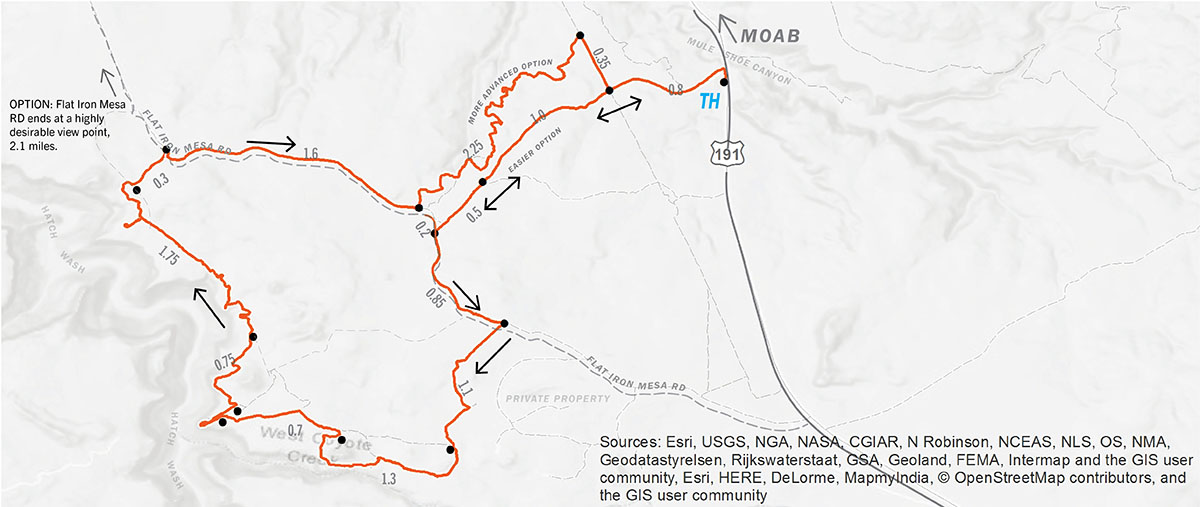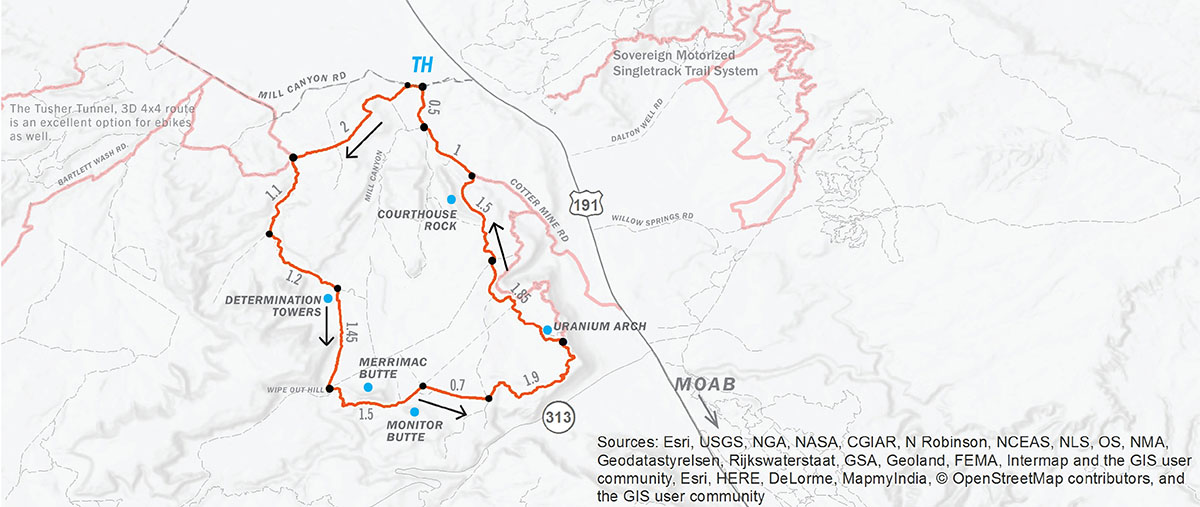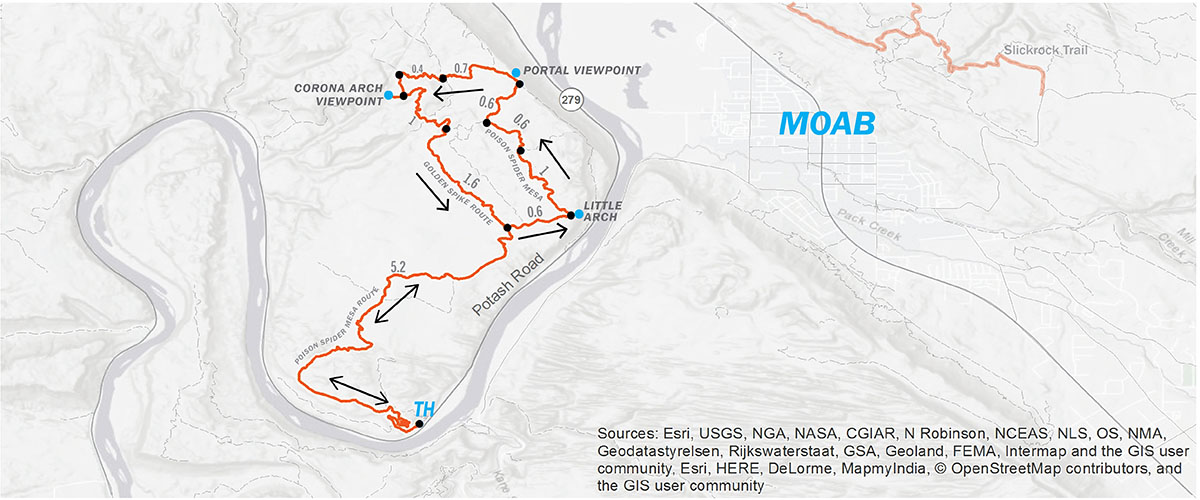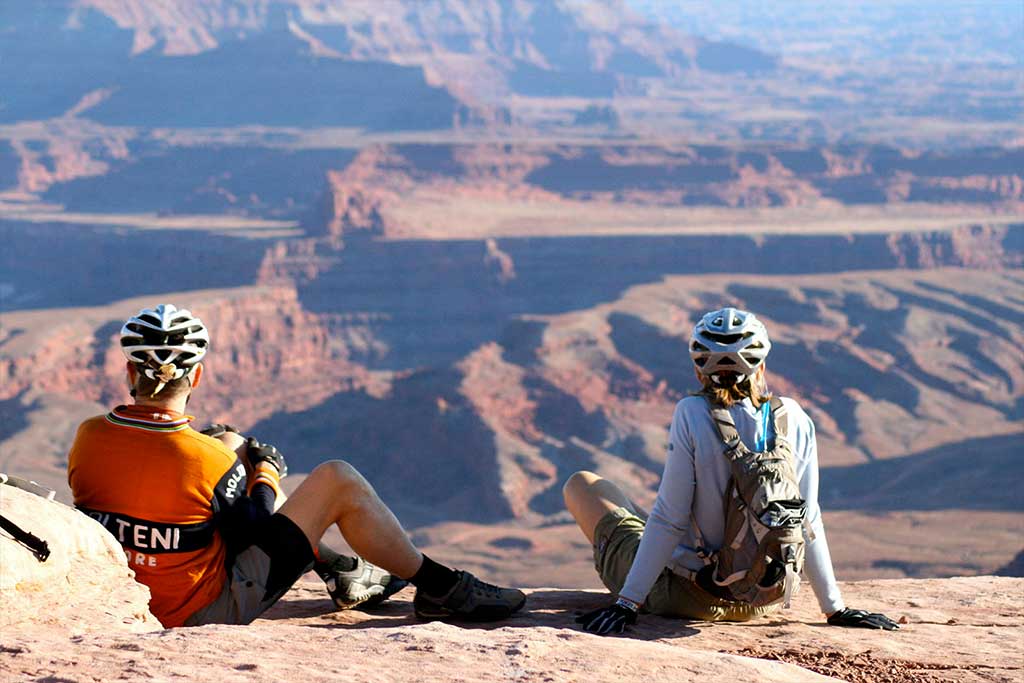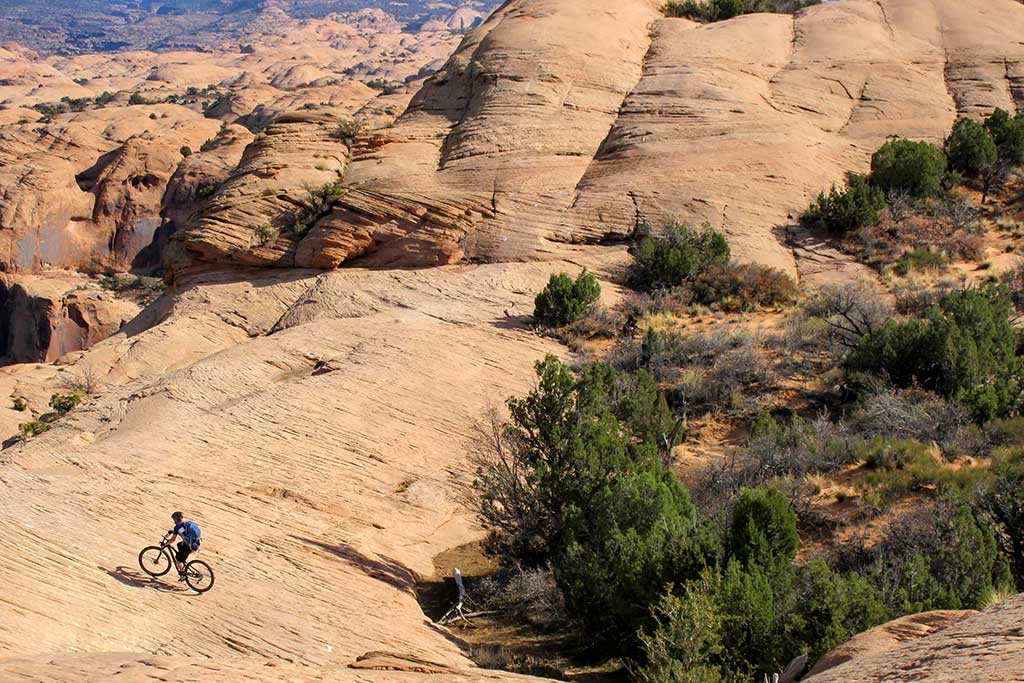Resources
Brochure
Sand Flats Recreation Area Visitor Guide
Sand Flats on the Web
Visit the
Sand Flats Recreation Area on the web at
grandcountyutah.net or on
Facebook.
Other Bike Rides
Moab offers a huge variety of rides. From trails for beginners looking for a scenic ride through beautiful canyons
and mesa
tops, to highly technical trails.
Raptor Route is an excellent downhill route that is great on its own or to connect with the Whole Enchilada. The MOAB
Brand Trails: Bar M, Circle O, Rockin’A,
and Bar B, offer everything from
easy winding dirt roads to miles of intermediate slickrock.
Read more…
Bike Safety
The Moab area offers challenging riding amidst world-class scenery. The characteristics of the area that make it a special place for riding also make it extremely important to follow basic safety procedures. The Moab Bike Patrol has this to say:
Wear a helmet
Most trails are very rocky. Even the best riders can get tired
and make mistakes. Helmets can prevent or reduce the severity of head injuries.
Carry lots of water and high-energy food.
At least a gallon of water is recommended per person per day. There is no water on the trails
and summer temperatures often climb above 100 degrees Fahrenheit. Running out of water will put your health at risk. Eating at intervals provides an opportunity to rest
and the energy needed to complete the ride.
Carry trail maps and know how to use them to track your position
Maps for all bike
and 4×4 trails are available at the Entrance station
and all trailheads. Detailed topographic maps are available in Moab at bike shops, bookstores
and the Moab Information Center.
Stay found, save money.
Grand County has the highest incidence of search
and rescue in Utah. The high cost of these operations is normally the responsibility of the rescued party. If you decide that you have lost the trail, do not continue on in hopes of finding your own way. Retrace your route back towards the trailhead until you pick up the trail, find someone who knows the area, or return to the trailhead. If you cannot retrace your route, stay put, conserve energy
and water, make yourself visible
and await rescue. It’s always a good idea to let a friend or relative know
beforehand where you are going
and when you should return. If something goes wrong you have the comfort of knowing that they will get help.
Check your bike frequently.
Riding in Moab trails loosens headsets
and puts maximum stress upon frames
and components. Frequent inspections reduce the possibility of injury. Be prepared in case of emergency.
Don’t venture into remote areas with nothing but a t-shirt and shorts.
Carry a windbreaker, sunscreen, sunglasses, maps, matches or lighter, pump, patch kit, first-aid kit, a good bike tool kit
and extra food, water
and clothing.
Ride with someone else and stay together in case of problems.
Discuss your situation calmly
and make a plan to improve it.
Frequently Asked Questions
How do I get to the Sand Flats Recreation Area?
The Sand Flats Recreation Area is located near Moab, Utah.
To get to the Sand Flats Recreation Area from the north and Interstate 70 take exit 182 toward Moab. Merge onto US-191 and go 31 miles to the third traffic light. At the light turn left onto 100 North. Proceed ½ mile and turn right onto 400 East. Go ½ mile and turn left at Dave’s Corner Market onto Millcreek Drive. Proceed for ½ mile to stop sign. Go straight at stop sign onto the Sand Flats Road that continues up a hill for 2 1/2 miles to the Entrance Booth.
To get to the Sand Flats Recreation Area from south of Moab on U.S. 191 turn right at first traffic light onto 400 East. Proceed for 1 mile to Dave’s Corner Market and Millcreek Drive. Make a right onto Millcreek Drive and proceed for ½ mile to stop sign. Go straight at stop sign onto the Sand Flats Road that continues up a hill for 2 1/2 miles to the Entrance Booth.
Who manages the Sand Flats Recreation Area?
The Sand Flats Recreation Area is managed through a unique partnership between Grand County and the Bureau of Land Management. In 1995, in response to repeated health and resource violations. this area was developed through the collaborative efforts of Americorps, the BLM, Grand County and the Moab community.
You can help our unique partnership efforts by taking responsibility for the lands you enjoy. Learn the guidelines of sustainable land use by:
- Understanding how your use affects the land
- Adopting minimum impact practices
- Sharing in the costs of services, education and maintenance
What is the user fee at the Sand Flats Recreation Area?
The Sand Flats’ day use pass is $10 and good for 7 days. Bicycle and motorcycle day use passes are $5 for 7 days.
Does my federal or state pass work at Sand Flats?
The Sand Flats Recreation Area (SFRA) is managed by Grand County in partnership with the Bureau of Land Management. SFRA functions as a self-sustaining entity with its operating budget derived entirely from collected fees and does not receive tax dollars from Grand County or the Bureau of Land Management. Since day to day management of the Sand Flats Recreation Area is performed by Grand County,federal passes are not accepted, with the exception of the Federal “Access” pass. State passes are not accepted because the Sand Flats Recreation Area is not part of the Utah State Park system.
Where do my fees go?
All user fees remain in this program and go toward services, maintenance and improvements. Services include staffing the Entrance Station, campground and backcountry patrols, educational displays, brochures and maps. General maintenance includes upkeep of campgrounds, toilet facilities, trails, fences, signs and associated materials.
User fees also sustain an apprenticeship program that provides work-study opportunities for local high school students. Collected fees help to support the operation of Grand County Search and Rescue. Funds are also used for matching grants to improve trailheads, trails and campground facilities.
Does Sand Flats have an annual pass? How do I purchase a pass?
Yes, Sand Flats sells an annual pass for $25. The pass admits the card-holder and passengers in a single, private vehicle for day use through the last day of the month and year indicated on the pass. When entry is by bicycle, motorcycle or shuttle van, this pass covers card-holder and accompanying family members. This pass does not cover camping. This pass is non-transferable and nonrefundable.
One can purchase a pass at the Entrance Station from March through October. Year round a pass can be purchased at the Grand County Clerk’s office in the Grand County Courthouse, 125 East Center St., Moab, Utah, Monday through Friday, 8 a.m.- 5 p.m. Closed holidays.
Can I camp at the Sand Flats Recreation Area and what does it cost?
Yes, Sand Flats has 140 individual campsites, open year round and offered on a first-come, first-serve basis (non-reservable). Camping is limited to these designated sites spread over nine campgrounds ranging from 4500 to 5700 feet in elevation. Campsite amenities include picnic tables, metal fire rings and nearby vault toilets. Campers need to bring in all their drinking water, as water is not available.
Some campsites can accommodate RVs. The best choices are in campgrounds Alcove (A), Bobcat (B), Echo (E), and Juniper. There are no hook-ups. Learn more about Sand Flats Recreation Area camping.
Camping at Sand Flats costs $15 per night, per car for up to 5 people. Additional persons cost $2 each per night. A $5 vehicle trailer fee per night also applies.
What are the Sand Flats Recreation Area camping regulations?
Camping Rules, Regulations and Other Information
- Camp only in a designated site. 10 people, 2 vehicles maximum per site
- Park vehicle and trailer in designated parking area
- Tent must be on a tent pad or within rock lined area and no more than 30′ from metal fire ring.
- Build fires in metal fire ring only. Bring in your own firewood; no wood pallets. Gathering or cutting of firewood is prohibited; do not collect organic material. No wood pallets. Do not put rocks or trash in the fire ring. Ashes must be cold to the touch when you leave camp. Use water to put your fire out, not sand.
- No littering. A trash dumpster is located at the Slickrock Bike trailhead and Fins and Things parking areas.
- Use toilet facilities
- Quiet Hours: 10 p.m. to 8 a.m. No generator use from 8 pm to 8 am
- For after hour noise disturbance, call Grand County Sheriff’at 435-259-8115
and kept under restraint. Please clean up after your pet.
- No discharging of firearms or fireworks
- Campsite checkout time is 11 a.m.
- Camping is limited to 14 days within a 30 day period
- A trash dumpster is located at the Slickrock Bike trail parking lot.
- Operation of motorized vehicle or mountain bike off designated roads and trails is a class A misdemeanor punishable by fine, imprisonment and/or forfeiture of vehicle. There are no open play areas, campground included. Do not idly drive around in camping, picnicking and trailhead areas.
- The Fins and Things 4×4 trail section that lies south of the Sand Flats road is open for Day Use Only and restricted one half hour before sunset until one half hour after sunrise.
- Maximum speed on 4×4 trails is 15 MPH.
- Please protect Moab’s aquifer and carry spill kits for trailside repairs and cleanup.
- Drive or Ride Safe and Sober
- To report off road travel or vandalism call Grand County Sheriff at 435-259-8115
- Emergencies call 911
- Respect Archeological, Paleontological and Natural Resources. Unauthorized removal or destruction is prohibited. Do not deface any surfaces with graffiti.
- Dumping: None
- Water: None
Does Sand Flats take group site reservations?
- Yes, Sand Flats has six reservable group campsites with four located in the Datura (D) campground and two located in the Echo (E) campground.
- The reservation fee is $8. The camping fee is $60 per night.
- The sites will accommodate 16 people. For more information on vehicle size limitations please go to Group Site Reservations below. All vehicles and trailers must fit within the assigned parking area.
- The group leader is responsible for being familiar with all of the Rules and Regulations of the Sand Flats Recreation Area and for ensuring other members of the group adhere to these rules. The group may be asked to leave by the Management for major noise complaints, facility or resource damage. The leader may receive a citation for excessive noise during quiet hours, or substantial resource or facility damage to the site.
- If you would like to reserve a site please go to Group Site Reservations. If you have a group larger than 16 people and want to reserve a group campsite in the area you can call the BLM at 435-259-2100 or visit Moab BLM group campsites .
What is minimum impact?
Each year, millions of visitors enjoy Canyon Country. The impact of so much use is threatening the area’s biological resources. You can help protect this fragile and beautiful land by following minimum-impact practices.
- Tread lightly when traveling and leave no trace of your camping.
- Drive and ride only on roads and trails where such travel is allowed; hike only on established trails, on rock or in washes.
- Avoid taking shortcuts and traveling through biological soil crusts.
- When camping do not place your tent on top of vegetation.
- Select an area of bare soil for your tent. .
- Use existing fire rings and bring in your own firewood.
- Do not strip bark, cut or break off tree limbs.
- Wood collecting of any kind is illegal at the Sand Flats Recreation Area.
- Please remember these trees provide shade and shelter for you, other campers and the animals that make the desert their home.
- Help keep Canyon Country clean.
- Pack out your trash and recycle it, clean up after less thoughtful visitors, and use toilets.
- Protect and conserve scarce desert water sources.
- Leave potholes undisturbed.
- Allow space for wildlife.
- When encountering wildlife, maintain your distance and remain quiet.
- Teach children not to chase or pick up animals.
- Keep pets under control.
What is biological soil crust?
Biological soil crust is a living crust of cyanobacteria (blue-green algae), bacteria, algae, lichen, mosses and fungi that covers much of the soil surface in this area. It is almost invisible in its early stages. As it matures, it develops a bumpy, blackish surface. The crust is essential to desert life. It holds sand together, retains water, and makes nutrients needed for larger plants to grow.
It takes over 100 years for the crust to reach full development, yet tire tracks and footsteps can crush it instantaneously. Bike and vehicle tire tracks are especially damaging because they form ruts. When it rains water flows in these ruts causing severe erosion. Drive or bike only on open roads or trails. When hiking cross-country, walk on slickrock or in dry washes to avoid trampling biological soil crust.
What are the Sand Flats Recreation Area day use regulations?
- The right to use public lands comes with the responsibility of caring for those lands.
- Operation of motorized vehicle or mountain bike off designated roads and trails is a class A
misdemeanor punishable by fine, imprisonment and/or forfeiture of vehicle. To report off road travel
or vandalism call 435-259-8115.
- Drive or Ride Safe and Sober.
- Maximum speed on 4X4 trails is 15 MPH.
- The Fins and Things 4×4 trail section that lies south of the Sand Flats road is open for Day Use Only and restricted one half hour before sunset until one half hour after sunrise.
- There are no open play areas, campgrounds included. Do not idly drive around in camping, picnicking and trailhead areas.
- Parking is provided in designated areas. Do not park on vegetation or on roadside shoulders.
- Do not litter. A trash dumpster and recycling bin is located at the Slickrock Bike Trail and Fins and Things parking areas.
- Use toilets located at trailheads and in campgrounds. In the backcountry, pack out human waste in an approved waste kit.
- No Shooting or Fireworks.
- For emergencies call 911.
- Dogs must be kept under restraint. No unattended dogs. Please clean up after your pet.
- Respect Archeological, Paleontological and Natural Resources. Unauthorized removal or destruction is prohibited. Do not deface any surfaces with graffiti.
What do I need to know for playing it safe when riding my bike at Sand Flats?
The Moab area offers challenging riding amidst world-class scenery. The characteristics of the area that make it a special place for riding also make it extremely important to follow basic safety procedures. The Moab Bike Patrol has this to say:
Wear a helmet. Most trails are very rocky. Even the best riders can get tired and make mistakes. Helmets can prevent or reduce the severity of head injuries. Carry lots of water and high-energy food. At least a gallon of water is recommended per person per day. There is no water on the trails and summer temperatures often climb above 100 degrees Fahrenheit. Running out of water will put your health at risk. Eating at intervals provides an opportunity to rest and the energy needed to complete the ride.
Carry trail maps and know how to use them to track your position. Maps for Slickrock and Porcupine Rim trails are located at the trailheads and entrance station. Detailed topographic maps are available in Moab at bike shops, bookstores and the Moab Information Center. Stay found, save money. Grand County has the highest incidence of search and rescue in Utah. If you decide that you have lost the trail, do not continue on in hopes of finding your own way. Retrace your route back towards the trailhead until you pick up the trail, find someone who knows the area, or return to the trailhead. If you cannot retrace your route, stay put, conserve energy and water, make yourself visible and await rescue. It’s always a good idea to let a friend or relative know beforehand where you are going and when you should return. If something goes wrong you have the comfort of knowing that they will get help.
Check your bike frequently. Riding in Moab trails loosens headsets and puts maximum stress upon frames and components. Frequent inspections reduce the possibility of injury. Be prepared in case of emergency. Don’t venture into remote areas with nothing but a t-shirt and shorts. Carry a windbreaker, sunscreen, sunglasses, maps, matches or lighter, pump, patch kit, first-aid kit, a good bike tool kit and extra food, water and clothing. Ride with someone else and stay together in case of problems. Discuss your situation calmly and make a plan to improve it.
Where can I ride my e-bike at Sand Flats?
E-Bikes are considered motorized vehicles on public lands, therefore they are prohibited on non-motorized trail sections, such as the single-track portions of the Porcupine Rim/Whole Enchilada trail systems. E-Bikes are welcome on the Slickrock Bike Trail and on all of the 4×4 trails in Sand Flats. Remember that motorized traffic yields to non-motorized traffic. Please note that travel is limited to designated trails and that cross-country travel is not permitted. Stay on the trail. Pack it in. Pack it out. Responsible recreation keeps this trail clean, scenic and OPEN.
How difficult is mountain biking on the Slickrock Bike trail?
The Slickrock Bike trail is rated as difficult. Terrain consist of rugged and rolling sandstone with occasional sandy spots. It’s steep inclines and descents offer technical challenges to the most experienced bikers. The 1.7 mile practice loop is recommended for all first time visitors. It is still rated as difficult and not for novice riders or young children. Be aware of narrow ledges, abrupt drop-offs and cliffs. Tough spots may require walking bikes. Due to numerous steep ascents, many mountain bikers need 3-4 hours to complete the trail. Motorcyclists need 1 plus hours. Beware of vehicles as the trail crosses Hell’s Revenge 4×4 trail six times. The trail is marked with white dashes painted on the rock surface. Please note that travel is limited to designated trails and that cross-country travel is not permitted. The trail is closed to ATVs and 4x4s.
What is the Porcupine Rim Trail like?
The "other mountain biking trail" at SFRA is the Porcupine Rim Trail, popular and difficult in it’s own right. The west trailhead is located on the eastern end of SFRA, 7 miles up the Sand Flats road from the Entrance Station.
The first part of the trail is popular with motorcycles and jeeps. At mile 8.6 the trail becomes single track with steep ledges and is suitable only for biking and hiking. All motorized vehicles must turn around at this point including e-bikes. The official trail length from the trailhead to highway 128 is 14.4 miles but because it is a one-way trail, without a shuttle, it is 30 miles round trip. The trail offers a variety of riding surfaces in a remote and rugged area of outstanding scenery.
Please note that travel is limited to designated trails and that cross-country travel is not permitted. Stay on the trail. Pack it in. Pack it out. Responsible recreation keeps this trail clean, scenic and open.
What is the LPS trail?
The higher entry point for the Porcupine Rim Trail within the Sand Flats Recreation Area is the Lower Porcupine Single-track or LPS trail. The LPS trailhead is at the Manti La Sal National Forest boundary, 11 miles east of the Sand Flats Entrance Station on the Sand Flats road. No motorized vehicles, which includes e-bikes, are permitted on LPS.
The LPS trail is technically challenging. The trail splits into a rim ride section and the Notch section. The Notch is for experts only. The rim ride section has an entry drop that is difficult. Most hoof it over these obstacles. The trail has numerous drops and slickrock to negotiate. Average grade is 11%. LPS is the 5th ride of the Whole Enchilada. For more information see the Whole Enchilada map.
Where can I hike at Sand Flats?
Hiking areas and trails include the Slickrock Bike Trail Practice Loop, the Pinyon Interpretive Hiking Trail, the Juniper Hiking Trail and the Porcupine Rim to Castle Valley overlook route. Trails range in length from 1 to 5 miles or more. See Hiking section.
Does Sand Flats have 4×4 trails?
Moab’s Four-wheel drive trails are world renowned for their combination of challenge and awesome scenery. Two main trails for 4x4s at the Sand Flats Recreation Area are the Fins and Things 4×4 Trail and the Hell’s Revenge 4×4 Trail both rated difficult. Stock vehicles are not recommended on the Hell’s Revenge Trail. A stock vehicle can be on the Fins and Things 4×4 Trail if it has good articulation, high ground clearance, and adequate front and rear approach angles.
Please note that travel is limited to designated trails and that cross-country travel is not permitted. The Moab area offers literally thousands of miles of old roads. Stay on the trails and leave the scenery for others to enjoy. Tracking the landscape is one of the most lasting forms of damage.
Do not trample vegetation or biological soil crusts. Avoid driving in potholes. Respect all living things. The desert is an irreplaceable gift. Pack it in. Pack it out. Responsible recreation keeps this trail clean, scenic and open. For current OHV regulations please visit recreation.utah.gov.
What are some safety tips for traveling in the Sand Flats backcountry by motorized vehicle?
Let someone know your itinerary. First and foremost it’s always a good idea to let a friend or relative know beforehand where you are going and when you should return. If something goes wrong you have the comfort of knowing that they will get help. Travel with another vehicle. Your chances of getting stuck in the backcountry are reduced with two vehicles; if one breaks down you have a way out.
Carry trail maps and know how to use them to track your position. Maps for all trails are located at trailheads and the entrance station. Detailed topographic maps and guidebooks are available in Moab at bike shops, bookstores and the Moab Information Center.
If you decide that you have lost the trail, do not continue on in hopes of finding your own way. Retrace your route back towards the trailhead until you pick up the trail. Changing conditions- Directional signs may be removed or vandalized. New roads can spring up. Use your map or guidebook but exercise common sense when discrepancies occur.
Inspect your vehicle. Before going in the backcountry make sure that your vehicle it is in top operating condition. Drive or ride safe and sober. It is illegal in Utah for any occupant of a vehicle to drink or even open an alcoholic beverage. Please remember to buckle up.
Where can I ride my ATV at Sand Flats?
All-Terrain Vehicles (ATVs) are permitted on all 4×4 trails at Sand Flats, however the Hell’s Revenge and the first 2 miles of the Fins and Things trail are not recommended. The first 8.6 miles of the Porcupine Rim trail are open to ATVs but still rated as difficult. The Slickrock Bike Trail is open to motorcycles and bicycles and is closed to all four-wheeled vehicles.
Remember that motorized traffic yields to non-motorized traffic. Please note that travel is limited to designated trails and that cross-country travel is not permitted. Stay on the trail. Pack it in. Pack it out. Responsible recreation keeps this trail clean, scenic and OPEN. For current OHV regulations please visit recreation.utah.gov.
Where can I ride my UTV at Sand Flats?
UTVs or Utility Terrain Vehicles are welcome on all the same trails as 4×4’s at the Sand Flats Recreation Area. UTVs are prohibited on the Slickrock Bike Trail and the single-track portions of the Porcupine Rim/Whole Enchilada trail system. Remember that motorized traffic yields to non-motorized traffic. Please note that travel is limited to designated trails and that cross-country travel is not permitted. Stay on the trail. Pack it in. Pack it out. Responsible recreation keeps this trail clean, scenic and OPEN. For current OHV regulations please visit recreation.utah.gov.
Where can I ride my motorcycle at Sand Flats?
Motorcycles are permitted on the Slickrock Bike Trail. In fact, the trail was originally designed in 1969 for motorcycles. SFRA also offers over 40 miles of 4×4 trails that motorcycles are welcome to ride. These include Fins and Things 4×4 Trail, Porcupine 4×4, Hells Revenge Trail and the first 8.6 miles of the Porcupine Rim Trail. Please note that the Porcupine Rim single-track and LPS single-track are non-motorized.
Remember that motorized traffic yields to non-motorized traffic. Please note that travel is limited to designated trails and that cross-country travel is not permitted. Stay on the trail. Pack it in. Pack it out. Responsible recreation keeps these trails clean, scenic and open. For current OHV regulations please visit recreation.utah.gov.
Can I bring my dog?
Yes, but please note that Grand County "Animal Care and Control" code does apply.
- All dogs shall be kept under restraint.
- No owner shall fail to exercise proper care and control of his or her animals to prevent them from becoming a public nuisance.
In the campground animals must be on a leash secured to a fixed object or under the control of a person or otherwise physically restricted at all times. In the backcountry dogs need to be under restraint and not chase or harass people or wildlife. No unattended dogs.
Helpful Information for Dog Owners
- A good place to take your dog for a walk is to hike one of the less used 4×4 trails such as the Porcupine 4×4 trail or Porcupine Rim trail.
- If you are riding one of the bike trails leave your dog at one of the Moab kennels listed below.
- Most dogs are not used to running on sandstone, which acts like sandpaper on their paws.
- Never leave your dog in a parked car; temperatures rise to dangerously high levels quickly in the desert.
- Owners should carry water for their pet.
- Owners need to clean up after their pet.
Moab Veterinary Clinic: 435-259-8710. Moab National Bark: 435-259-7922. For lost dogs or problem dogs, call Animal Control at 435-259-8115.
For more additional information about visiting the Moab area with pets, click here.
Do you waive fees for volunteer groups?
As a self-sustaining program, we cannot afford to waive fees. We will, however, waive up to half of the camping fees for at least one full day of volunteer service. This half price fee is at the decision of the director.
We also have a scheduled volunteer service program that gives participants an annual pass for day-use valued at $25. Dates for these events are advertised in local papers and radio and usually held in the spring and fall.
The volunteer labor of local and visiting volunteer groups are important contributions to operations at the Sand Flats Recreation Area.
